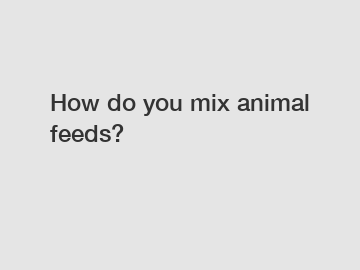How do you mix animal feeds?
How do you mix animal feeds?
When it comes to mixing animal feeds, there are several important factors to consider. The process involves blending various ingredients to create a balanced and nutritious feed that meets the dietary needs of different animals. By understanding the intricate details of feed mixing, livestock farmers can ensure that their animals receive the optimal nutrition necessary for growth, productivity, and overall health.
To begin with, feed mixing starts with careful ingredient selection. Farmers must choose high-quality and nutrient-rich ingredients such as grains, protein sources (e.g., soybean meal), vitamins, minerals, and additives. These ingredients vary depending on the type of animal being fed, as different species have different nutritional requirements. For example, a feed mix for poultry will contain a higher proportion of grains and protein sources compared to one for ruminants such as cows or goats.

Once the ingredients are selected, they are weighed and proportioned accordingly. This step is crucial to ensure that the desired nutrient composition is achieved. Accurate weighing is essential as it directly impacts the nutritional content of the feed and prevents under or overfeeding. Modern feed milling equipment and computerized systems have made this process more efficient and accurate.
After weighing, the ingredients are thoroughly mixed. This ensures that the different components of the feed are evenly distributed, eliminating any clumps or inconsistencies. Mixers are used to blend the ingredients together, and the duration and intensity of the mixing process depend on the type of feed being produced. Uniformity of the mix is crucial for ensuring that all animals receive the same essential nutrients in each bite, promoting optimal growth and health.
The significance of proper feed mixing cannot be overstated. Well-mixed animal feeds lead to better nutrient utilization, improved feed conversion, and enhanced animal performance. When animals receive a consistent diet that meets their nutritional needs, they are less likely to suffer from deficiencies or imbalances, resulting in healthier and more productive livestock. In addition, carefully formulated feeds can help prevent diseases and improve the overall well-being of the animals.
Moreover, efficient feed mixing practices have a positive environmental impact. By minimizing nutrient losses and optimizing nutrient distribution, the chances of nutrient runoff into water bodies are reduced. This helps protect water quality and prevents the pollution of surrounding ecosystems. Additionally, when animals efficiently utilize the nutrients provided in their feed, less feed is wasted, minimizing the environmental footprint of livestock production.
In conclusion, the process of mixing animal feeds involves careful ingredient selection, accurate weighing, and thorough blending. It is a crucial step in ensuring the nutritional well-being of livestock. Proper feed mixing contributes to optimal animal growth, improved feed conversion, and ultimately results in healthier and more productive animals. Additionally, it has positive environmental impacts by reducing nutrient losses and waste. By understanding and implementing effective feed mixing practices, farmers can provide their animals with balanced and nutritious diets, promoting sustainable and responsible livestock production.
If you are looking for more details, kindly visit feed cleaner machine, powder mash precleaner, animal feed coating machine.
101
0
0


Comments
All Comments (0)